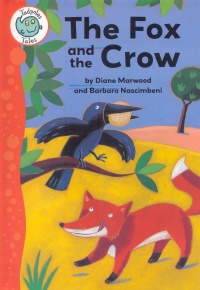| ________________
CM . . .
. Volume XIX Number 17. . . .January 4, 2013
excerpt:
So begins this book for emergent readers. In Diane Marwood and Barbara Nascimbeni’s book, they share a fable about a vain crow and a clever fox. The fox capitalizes on the crow’s narcissistic tendencies in order to steal food. The fox tells the crow that her voice is beautiful, and when the crow opens her beak to sing a song, the fox runs away with the delectable morsel that falls down. This tale shares a lesson about the problems that can arise as a result of vanity. At the beginning of the book, Marwood includes an explanation about fables that contains kid-friendly language. Following her explanation, Marwood challenges readers to identify the lesson in the story. A page at the back of the book contains notes for adults with suggestions in regards to how the book can be used as a tool for children learning to read. The words of the story are printed in large text, and Marwood includes a number of high frequency words. A criticism often levelled against emergent texts is that there is no story for the reader to follow, and, as a result, there is little to capture a reader’s interest. I think that Marwood finds a very interesting story and delivers it in a way that holds the reader’s attention throughout the reading experience. I do feel that an emergent reader would need some assistance the first time or two reading this text as the inclusion of words like “clever” and “gobbled” would most likely fall outside of the reading ability of the emergent reader. Having said this, I feel that the cohesive story line, along with illustrations that provide readers with hints regarding challenging words, would make this an enjoyable experience for children beginning their reading journey. Nascimbeni’s art work elevates the reading experience of this text. She uses large and simple shapes, and the vibrant colours capture the reader’s attention. Nascimbeni manages to include a variety of expressions on the faces of the fox and the crow, beautifully complementing the progression of the storyline. Her illustrations play a role in reader comprehension at the end of the book where children are invited to put a scrambled version of Nascimbeni’s illustrations in the order in which they appeared in the story. The Fox and the Crow would be a welcome addition to any Kindergarten or Grade 1 class library, and it would also be a good choice for parents of children who are just beginning to read. This book fills a niche in that it does not sacrifice storyline, even though the language caters to emergent readers. Recommended. Leanne Ryrie teaches second grade in Winnipeg, MB.
To comment
on this title or this review, send mail to cm@umanitoba.ca.
Copyright © the Manitoba Library Association. Reproduction for personal
use is permitted only if this copyright notice is maintained. Any
other reproduction is prohibited without permission.
NEXT REVIEW |
TABLE OF CONTENTS FOR THIS ISSUE
- January 4, 2013.
AUTHORS |
TITLES |
MEDIA REVIEWS |
PROFILES |
BACK ISSUES |
SEARCH |
CMARCHIVE |
HOME |
